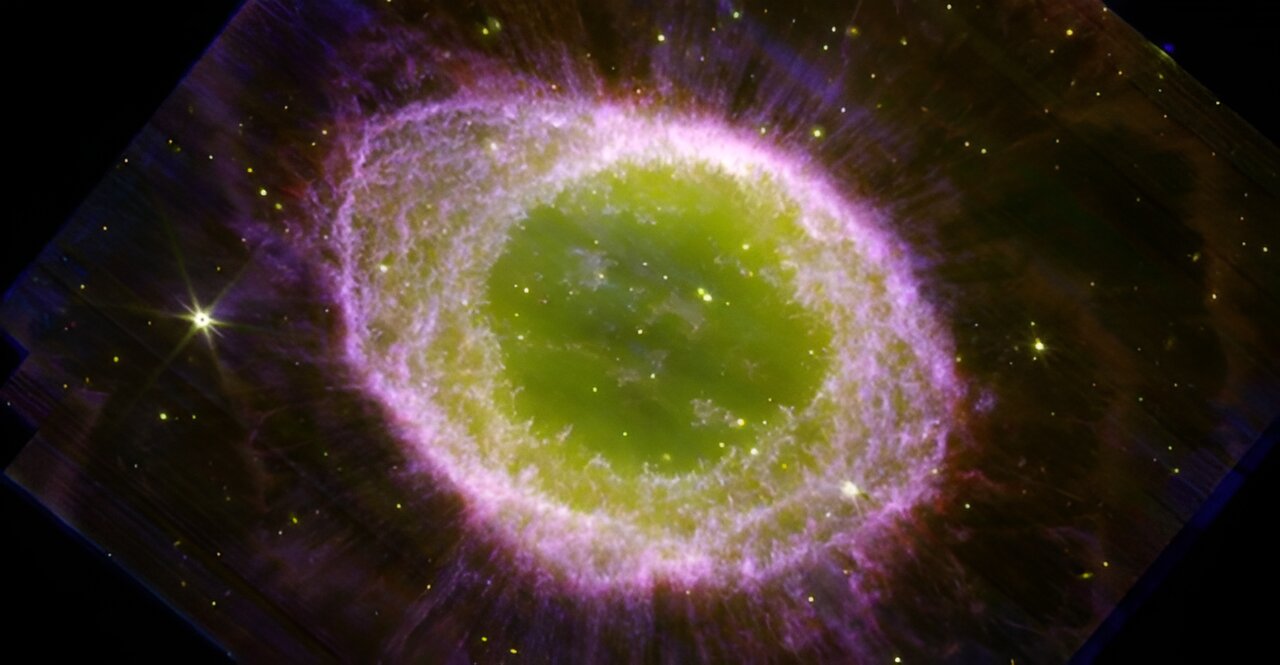JWST/NIRcam composite image of the Ring Nebula. The images reveal the main ring, surrounded by a faint halo and intricate structures. The ring is filled with hot gas, expelled by the central star visible at its core, which has a temperature exceeding 100,000 degrees. This nebula was ejected a mere 4000 years ago.
Technical details: This composite image was obtained using JWST’s NIRCam instrument on August 4, 2022. The image combines data from three different filters: F212N (blue), F300M (green), and F335M (red).
Credit: The University of Manchester
NASA’s James Webb Space Telescope (JWST) presents breathtaking new images of the iconic Ring Nebula, also known as Messier 57. This incredible view, released by an international team of astronomers led by Professor Mike Barlow (UCL, U.K.) and Dr. Nick Cox (ACRI-ST, France), along with Professor Albert Zijlstra of The University of Manchester, offers an unprecedented and mesmerizing glimpse into the beauty of this celestial wonder.
The Ring Nebula, located in the constellation Lyra, has long captivated sky enthusiasts and is visible throughout the summer. Even with a small telescope, one can observe its characteristic donut-like structure of glowing gas. These planetary nebulae are remnants of dying stars that have shed much of their mass during their final stages of life. The Ring Nebula’s unique structure and vibrant colors have always ignited human imagination, and now, thanks to JWST’s remarkable images, scientists and the public have an unparalleled opportunity to explore and comprehend the intricate processes that shaped this cosmic masterpiece.
A close examination of the outer halo reveals several hundred linear features, pointing towards the central star, their origin currently unknown. The formation of such a complex nebula through the actions of a single star remains a mystery. JWST’s mission includes a study of these clumps and stripes, aiming to uncover their structure and origin. Additionally, thousands of faint galaxies with clear spiral structures can be seen in the background.
Albert Zijlstra, Professor in Astrophysics at the University of Manchester, expresses his amazement at the image details, stating, “We always knew planetary nebulae were pretty. What we see now is spectacular.” Dr. Mike Barlow, the lead scientist of the JWST Ring Nebula Project, adds, “The James Webb Space Telescope has provided us with an extraordinary view of the Ring Nebula that we’ve never seen before. The high-resolution images not only showcase the intricate details of the nebula’s expanding shell but also reveal the inner region around the central white dwarf in exquisite clarity.”
The Ring Nebula serves as a testament to the stellar life cycle, located approximately 2,600 lightyears away from Earth. It originated from a dying star that expelled its outer layers into space. These nebulae captivate with their various shapes and patterns, often featuring delicate rings, expanding bubbles, or intricate, wispy clouds. A close-up reveals that the ring consists of numerous small clumps, with up to 20,000 identified. These clumps, containing molecular hydrogen, are cooler and denser than the rest of the nebula. Some even develop tails, akin to comets the size of planets. About half of the nebula’s gas resides within these clumps.
Another close-up of the halo showcases wisps, where hot gas sweeps up the material. These patterns are the result of complex interactions between different physical processes yet to be fully understood. The layers are now illuminated by the light emitted from the hot central star. Just like fireworks, different chemical elements in the nebula emit light of specific colors, creating colorful and captivating objects. This phenomenon allows astronomers to study the chemical evolution of these objects in great detail.
The international research team, consisting of scientists from various countries, highlights that JWST/MIRI images of the Ring Nebula will be available soon.
Provided by: University of Manchester
Citation: James Webb Space Telescope captures stunning images of the Ring Nebula (2023, August 3) retrieved 3 August 2023 from https://phys.org/news/2023-08-james-webb-space-telescope-captures.html
Denial of responsibility! TechCodex is an automatic aggregator of the all world’s media. In each content, the hyperlink to the primary source is specified. All trademarks belong to their rightful owners, and all materials to their authors. For any complaint, please reach us at – [email protected]. We will take necessary action within 24 hours.

Jessica Irvine is a tech enthusiast specializing in gadgets. From smart home devices to cutting-edge electronics, Jessica explores the world of consumer tech, offering readers comprehensive reviews, hands-on experiences, and expert insights into the coolest and most innovative gadgets on the market.


